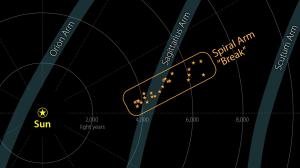Blog
Point Break
21 August 2021
 NASA/JPL-Caltech
NASA/JPL-CaltechThe Milky Way galaxy is our home, and yet in some ways, it is the least understood galaxy. One of the biggest challenges astronomers have is in understanding its large-scale structure. Because we’re in the midst of it all, mapping our galaxy is a bit like trying to map the size and shape of a wooded park while standing in the middle of it.
One of the ways astronomers can map our galaxy is to measure the position and distance of thousands upon thousands of stars. This is one of the main goals of the Gaia mission, which studies the location and motion of more than a billion stars. Gaia has already revealed details in the structure of the Milky Way, such as a wave pattern among some stars.
 NASA/JPL-Caltech
NASA/JPL-CaltechAnother method is to look at specific objects in our galaxy, such as star-forming nebulae. Star-forming nebulae tend to be located within the spiral arms of a galaxy, where there is the most gas and dust. The Spitzer infrared space telescope has measured the distances to young stars within many nebulae, which helped us confirm that the Milky Way has four main spiral arms.
A new study combines data from Gaia and Spitzer, comparing the location of some nebulae with the overall spiral distribution of stars.1 The study focused on a main spiral arm within the galaxy known as the Sagittarius Arm. It is the spiral arm just inward from the Sun’s arm of Orion. The team hoped to measure an aspect of the spiral arm known as the pitch angle. It tells you how tightly wound a spiral arm is. The larger the pitch angle, the more open the spiral arms are. In the case of the Sagittarius Arm, the pitch angle is about 12 degrees. But pitch the angle of some nebulae are very different.
 NASA/JPL-Caltech
NASA/JPL-CaltechThe team looked at four prominent nebulae in our night sky: the Eagle Nebula (which contains the Pillars of Creation), the Omega Nebula, the Trifid Nebula, and the Lagoon Nebula. These four nebulae are in the same general region and were used in the 1950s to confirm the existence of the Sagittarius Arm. This new study pinned down the location of these nebulae and other stars and found the region has a pitch angle of 60 degrees.
This doesn’t mean our original measure of the Sagittarius Arm is wrong, but it does point to a type of structure known as galactic spurs. Some spiral galaxies have very smooth spiral arms, where gas, dust, and star-forming regions are all along the same curve. Other spiral galaxies have more broken spiral arms, with small feathery offshoots called spurs. We don’t know for sure which type of galaxy the Milky Way is, but this new study points to it being the latter.
Kuhn, M. A., et al. “A high pitch angle structure in the Sagittarius Arm.” Astronomy & Astrophysics 651 (2021): L10. ↩︎